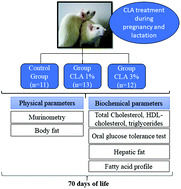Maternal consumption of conjugated linoleic acid improves tolerance to glucose and hdl-cholesterol in the rat progeny
Abstract
Our study evaluates the impacts of maternal consumption of different levels of CLA during pregnancy and lactation on physical and metabolic changes in the rat progeny. Three groups were formed: control (CG) – diet without CLA; CLA1 – diet containing 1% CLA; and CLA3 – diet containing 3% CLA. Murinometry, body fat collection, biochemical analysis, glycemic curves, liver fat amount, and fatty acid profiles of the liver were studied. The data were analyzed by ANOVA, followed by the Tukey test (p < 0.05). The CLA3 group presented highest body weight, feed intake and BMI (p < 0.05). The retroperitoneal fat, epididymal fat, and body fat index were higher in the CLA1 and CLA3 groups (p < 0.05) but no difference was observed for mesenteric fat. Yet in contrast, the experimental groups presented lower abdominal circumference and glycemic curves when compared to the CG (p < 0.05). CLA1 and CLA3 groups presented higher values of total cholesterol and HDL-cholesterol (p < 0.05), yet no difference was found in serum triglycerides or LDL. The CLA3 group presented less n-3, n-6, total PUFA, and arachidonic acid in liver fat (p < 0.05). The CLA1 and CLA3 groups were higher in total MUFA in the liver fat. In conclusion, CLA when consumed during gestation and lactation increased: tolerance to glucose, HDL, and the body fat index in the offspring. Only the CLA3 group presented reduced total PUFA, n-3, n-6 and arachidonic acid in the offspring's liver.



 Please wait while we load your content...
Please wait while we load your content...